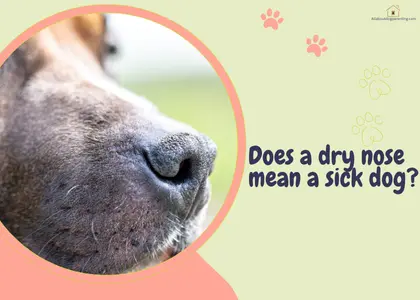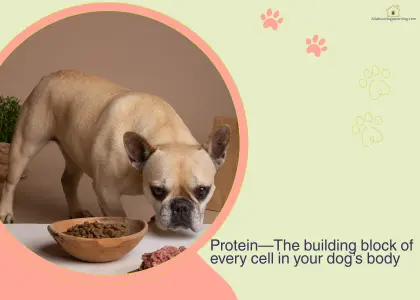Dry Nose in Dogs: When to Worry and How to Help
We all know the old tale that a wet nose means a healthy dog and a dry nose means sickness. But it’s just an old wives tale. In reality, dogs’ noses naturally cycle between wet and dry. A dry nose in dogs, on its own, say, right after sleeping or playing outside, is usually harmless. However, as with everything else, context matters.
Dog dry nose, accompanied by swelling, lethargy, loss of appetite, or some sort of discharge, for instance, warrants attention. If you’re unsure about when to worry about a dry nose in dogs and when it’s okay to let it slide, this guide is for you. I’ll take you through common causes of dry noses, the red-flag signs to watch for, gentle remedies, and prevention tips, based on my experience and insights from veterinarians.
Why Do Dogs’ Noses Get Dry?
Ever wondered, why do dogs’ noses get dry? To find the answer, you first need to know why dogs’ noses stay wet. Well, for two reasons: special glands secrete mucus onto the nose, and dogs lick their noses frequently to keep them moist. Because of this, the moisture level naturally fluctuates throughout the day.
For example, dogs often wake up with a dry nose because they haven’t licked it while snoozing. Similarly, a bit of sun, wind, or dry indoor air, from heaters or AC, can briefly dry out the snout. In cold, low-humidity climates, a dog’s nose can chap much like our lips do.
So, is a dry nose on a dog normal? Like I said, context is everything. A dog’s dry warm nose for a short while isn’t alarming. But if their nose stays persistently dry or becomes cracked, especially if paired with lethargy or poor appetite, you must pay attention. It could be a sign that your dog is unwell.
Common Causes of Dry Nose in Dogs

Dry noses can result from many everyday factors or medical issues. Here are the most common causes of dry nose in dogs:
- Normal Variations
Some dryness is perfectly normal. For instance, it’s common for a dog’s nose to be a little dry first thing in the morning. Brief environmental changes such as a sunny walk or a quick breeze can also leave the snout a bit drier. Dogs naturally have mechanisms to re-moisten their nose, so these harmless dry patches usually resolve on their own.
- Dehydration
Not drinking enough water can also result in a dog’s dry cracked nose, and this is often accompanied by other signs. Veterinarian Dr. Hunter Finn warns, “A dry nose may also be a symptom that your dog is severely dehydrated. Look for other clues like sunken eyes, sticky gums, or lethargy.” Make sure fresh water is always available and encourage your dog to drink, especially after exercise or in hot weather.
- Environmental Factors
The climate and surroundings play a big role. Hot sun, cold wind, or dry indoor heating/AC can strip moisture from a dog’s nose. In fact, sunburn is a common culprit. Dr. Finn says, “A sunburned nose will be dry and the skin may be cracked.” Dogs with pink or light noses are especially at risk. To protect them, use shade and pet-safe sunscreen. Controlling humidity indoors with a humidifier can also help prevent chapping.
- Allergies or Irritants
Seasonal allergies or household irritants can inflame the nasal skin. Pollen, dust mites, mold, or chemical sprays may make a dog’s nose red, itchy or flaky. Even plastic food bowls can contribute to nose irritation. If your dog’s nose looks irritated or he’s rubbing his face, try reducing known allergens: switch to stainless steel bowls, use unscented cleaning products, and wash bedding regularly. These steps often relieve allergy-related dryness.
- Health Issues
Dog dry nose and health problems are co-related. That’s where the wet nose means a healthy dog and a dry nose means sickness belief stems from. The differentiation factor is that when triggered by underlying health problems, the dryness is stubborn and doesn’t go away on its own.
Autoimmune diseases like lupus or pemphigus can destroy nose tissue, leading to chronic cracks or sores. Speaking of autoimmune dog dry nose, Dr. Finn warns, “These conditions lead to dryness, cracking, and bleeding of the nose. Dogs with chronically dry noses may develop nasal hyperkeratosis, which is a thick, crusty layer of skin.” Any time the nose is lumpy, crusty or cracked, you are dealing with dog dry nose health problems. These are clear signs you need to get a vet involved.
Dry Nose vs. Concerning Conditions: Key Differences
Here’s a quick comparison to help separate harmless dryness from worrisome cases:
| Condition | Duration | Texture | Symptoms | Impact |
| Harmless Dryness | Short-term. After naps, play, etc. | Slightly dry or warm, smooth | Dog is alert and playful; no other symptoms | Resolves on its own |
| Concerning Dryness | Persistent or worsening over days/weeks | Cracked, crusty, or flaky | Lethargy, appetite loss, nasal discharge, sores | Requires prompt vet care |
Use this table as a guide. A slightly warm, dry nose is usually harmless. But dry cracked dog nose, with very rough texture and accompanied by other concerning symptoms means there is an underlying problem, and it’s time to call the vet. Quick action on those red flags will protect your dog’s health.
Symptoms That Require Vet Attention
If you find yourself wondering when to worry about dry nose in dogs, watch out for the red flags. These dog dry nose symptoms usually mean that your pet is suffering from an illness and needs medical attention:
- Cracked or bleeding nose: Visible fissures or blood on the snout
- Sores or ulcers: Raw patches, scabs or inflammation on/around the nose
- Abnormal discharge: Yellow, green, or bloody nasal fluid
- Lethargy: Unusual weakness, listlessness or reluctance to move
- Loss of appetite: Refusal to eat or drink despite normally being hungry
- Swelling: Puffiness or inflammation around the muzzle, eyes or face
Home Remedies and Care for Dry Nose in Dogs

Once serious causes are ruled out and you want to help relieve the any discomfort brought on by the dryness, you can focus on gentle home care to soothe your dog’s nose:
- Hydration Support
Dog dry nose and hydration, or lack thereof, can be closely linked. You need to figure out how to keep dog hydrated. One surefire way is to keep clean water freely available at all times. You can encourage drinking by adding low-sodium bone broth or wet dog food to meals. In warm weather, give hydrating treats. Some dogs love chewing ice cubes or nibbling on frozen carrot sticks.
I make it a point to keep a bowl with fresh water near my dog’s bed, so he can lap it up first thing upon waking up. In summer months, popsicles and frozen treats work like a charm with him. Take the time to figure out what works best with your dog and use it effectively. Good hydration naturally helps keep the nose moist.
- Gentle Moisturizing
A reliable dog dry nose treatment at home is using a safe moisturizer. Apply a tiny amount of plain, unscented petroleum jelly or a vet-recommended nose balm to the snout once or twice a day. Pet balms, often called “Snout Soothers”, are popular home remedies for dry noses.
Just remember: do not use human lotions or essential oils on your dog’s nose, as these can irritate or even be toxic. In my experience, a little bit of Vaseline is the best balm for dog dry nose and is harmless if licked.
- Environmental Adjustments
Modify your dog’s environment to reduce drying. In winter or dry climates, run a humidifier at home to keep the air from getting too arid. In hot weather, limit sun exposure. Try to walk in the early morning or evening, and never leave your dog in a closed car. Avoid pointing heater or AC vents directly at your dog’s face. These simple dry nose home remedies often make a big difference.
- Allergies and Irritant Control
Eliminate potential dog dry nose irritants. Switch plastic food or water bowls to stainless steel or ceramic ones. Other effective dog dry nose allergies remedies include washing bedding and vacuuming floors often to cut down on dust, pollen, or mold in the air. Using hypoallergenic or unscented cleaning products and pet shampoos, changing laundry detergents or using a different air filter can also help clear up mysterious dryness. By reducing exposure to allergens, you’ll help keep the nose calm and moist.
Preventing Dry Nose in Dogs

Good proactive care keeps most nose problems at bay.
- Regular grooming such as wiping away crusts or debris and balanced nutrition, complete with omega-3 rich foods for skin health, are key to preventing dry nose in dogs
- Always keep your dog’s water bowl filled, and consider mixing water into dry food if she tends to drink little
- Stick to a consistent flea/tick prevention and keep up with vet visits
- Illnesses or skin conditions flagged during checkups do not escalate to a point that they result in symptoms such as dry nose in dogs
- Also, be mindful of the elements. Don’t let your pup bake in the hot sun or out in freezing winds without protection
- For light-colored noses, apply pet-safe sunscreen before outdoor time
- In winter, a humidifier by the dog’s sleeping area can prevent chapping from indoor heaters
In short, a steady regimen of grooming, diet support, parasite control and sun/humidity management goes a long way.
Takeaway
Most dry noses are harmless. With routine dog dry nose care, including plenty of water, gentle moisturizing, and some shade or sunscreen, you’ll keep your pup’s snout in top shape. A warm, slightly dry nose alone usually isn’t a reason to panic. You only need to worry about a dog’s dry nose if the problem is chronic or the nose is cracked and comes with other sick signs. Prevention is easier than treatment. Simple dog dry nose remedies like offering water, pet-safe balms, or a humidifier can head off problems early.







